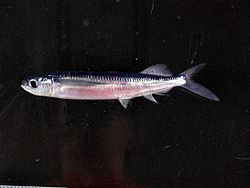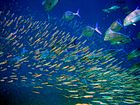Hemiramphidae
Hemiramphidae is a family of fishes that are commonly called halfbeaks, spipe fish or spipefish. They are a geographically widespread and numerically abundant family of epipelagic fish inhabiting warm waters around the world. The halfbeaks are named for their distinctive jaws, in which the lower jaws are significantly longer than the upper jaws. The similar viviparous halfbeaks (family Zenarchopteridae) have often been included in this family.
Though not commercially important themselves, these forage fish support artisanal fisheries and local markets worldwide. They are also fed upon by other commercially important predatory fishes, such as billfishes, mackerels, and sharks.
Taxonomy
In 1758, Carl Linnaeus was the first to scientifically describe a halfbeak, Esox brasiliensis (now Hemiramphus brasiliensis). In 1775 Peter Forsskål described two more species as Esox, Esox far and Esox marginatus. It was not until 1816 that Georges Cuvier created the genus Hemiramphus; from then on, all three were classified as Hemiramphus. In 1859, Gill erected Hemiramphidae, deriving its name from Hemiramphus, the family's type genus. The name comes from the Greek hemi, meaning half, and rhamphos, meaning beak or bill.
There are currently eight genera (including 60 species) within the family Hemirampphidae:
- Arrhamphus Günther, 1866
- Chriodorus Goode & Bean, 1882
- Euleptorhamphus Gill, 1859
- Hemiramphus Cuvier, 1816
- Hyporhamphus Gill, 1859
- Melapedalion Fowler, 1934
- Oxyporhamphus Gill, 1864
- Rhynchorhamphus Fowler, 1928

This family is primarily marine and found in the Atlantic, Pacific, and Indian Oceans, though some inhabit estuaries and rivers.
Evolution
The halfbeaks' fossil record extends into the Lower Tertiary. The earliest known halfbeak is "Hemiramphus" edwardsi from the Eocene at Monte Bolca, Italy. Apart from differences in the length of the upper and lower jaws, recent and fossil halfbeaks are distinguished by the fusion of the third pair of upper pharyngeal bones into a plate.
Phylogeny
| ||||||||||||||||||
| Phylogeny of the halfbeaks. |
The phylogeny of the halfbeaks is in a state of flux.
On the one hand, there is little question that they are most closely related to three other families of streamlined, surface water fishes: the flyingfishes, needlefishes, and sauries. Traditionally, these four families have been taken to together comprise the order Beloniformes. The halfbeaks and flyingfishes are considered to form one group, the superfamily Exocoetoidea, and the needlefishes and sauries another, the superfamily Scomberesocoidea.
On the other hand, recent studies have demonstrated that rather than forming a single monophyletic group (a clade), the halfbeak family actually includes a number of lineages ancestral to the flyingfishes and the needlefishes. In other words, as traditionally defined, the halfbeak family is paraphyletic.
Within the subfamily Hemiramphinae, the "flying halfbeak" genus Oxyporhamphus has proved to be particularly problematic; while morphologically closer to the flyingfishes, molecular evidence places it with Hemiramphus and Euleptorhamphus. Together, these three genera form the sister group to the flyingfish family. The other two hemiramphine genera Hyporhamphus and Arrhamphus form another clade of less clear placement.
Rather than being closely related to the flyingfishes, the subfamily Zenarchopterinae appears to be the sister group of the needlefishes and sauries. This is based on the pharyngeal jaw apparatus, sperm ultrastructure, and molecular evidence. However, this hypothesis has awkward implications for how the morphological evolution of the group is understood, because the fused pharyngeal plate has been considered reliably diagnostic of the halfbeak family. Furthermore, the existing theory that because juvenile needlefish pass through a developmental stage where the lower jaw is longer than the upper jaw (the so-called "halfbeak stage") the theory that halfbeaks are paedomorphic needlefish is untenable. In fact the unequal lengths of the upper and lower jaws of halfbeaks appears to be the basal condition, with needlefish being relatively derived in comparison.
Morphology

The halfbeaks are elongate, streamlined fish adapted to living in open water. Halfbeaks can grow to over 40 centimeters (16 in) SL in the case of Euleptorhampus viridis. The scales are relatively large, cycloid (smooth), and easily detached. There are no spines in the fins. A distinguishing characteristic is that the third pair of upper pharyngeal bones are anklylosed (fused) into a plate. Halfbeaks are one of several fish families that lack a stomach, all of which possess a pharyngeal jaw apparatus (pharyngeal mill). Most species have an extended lower jaw, at least as juveniles, though this feature may be lost as the fish mature, as with Chriodorus, for example.
As is typical for surface dwelling, open water fish, most species are silvery, darker above and lighter below, an example of countershading. The tip of the lower jaw is bright red or orange in most species.
Halfbeaks carry several adaptations to feeding at the water surface. The eyes and nostrils are at the top of the head and the upper jaw is mobile, but not the lower jaw. Combined with their streamlined shape and the concentration of fins towards the back (similar to that of a pike), these adaptations allow halfbeaks to locate, catch, and swallow food items very effectively.
Range and habitat

Halfbeaks inhabit warm seas, predominantly at the surface, in the Atlantic, Indian, and Pacific oceans. A small number are found in estuaries. Most species of marine halfbeaks are known from continental coastlines, but some extend into the western and central Pacific, and one species (Hyporhamphus ihi) is endemic to New Zealand. Hemiramphus is a worldwide marine genus.
Ecology and behavior
Feeding
Marine halfbeaks are omnivores feeding on algae; marine plants such as seagrasses; plankton; invertebrates such as pteropods and crustaceans; and smaller fishes. For some subtropical species at least, juveniles are more predatory than adults. Some tropical species feed on animals during the day and plants at night, while other species alternate between carnivory in the summer and herbivory in the winter. They are in turn eaten by many ecologically and commercially important fish, such as billfish, mackerel, and sharks, and so are a key link between trophic levels.
Behavior
Marine halfbeaks are typically pelagic schooling forage fish. The southern sea garfish Hyporhamphus melanochir for example is found in sheltered bays, coastal seas, estuaries around southern Australia in waters down to a depth of 20 meters (66 ft). These fish school near the surface at night but swim closer to the sea floor during the day, particularly among beds of seagrasses. Genetic analysis of the different sub-populations of the eastern sea garfish Hyporhamphus melanochir in South Australian coastal waters reveals that there is a small but consistent migration of individuals among theme, sufficient to keep them genetically homogeneous.
Some marine halfbeaks, including Euleptorhamphus velox and Euleptorhamphus viridis, are known for their ability to jump out of the water and glide over the surface for considerable distances, and have consequently sometimes been called flying halfbeaks.
Reproduction
Hemiramphidae species are all external fertilizers. They are usually egg-layers and often produce relatively small numbers of fairly large eggs for fish of their size, typically in shallow coastal waters, such as the seagrass meadows of Florida Bay. The eggs of Hemiramphus brasiliensis and H. balao are typically 1.5–2.5 mm (0.059–0.098 in) in diameter and have attaching filaments. They hatch when they grow to about 4.8–11 mm (0.19–0.43 in) in diameter. Hyporhamphus melanochir eggs are slightly larger, around 2.9 mm (0.11 in) in diameter, and are unusually large when they hatch, being up to 8.5 mm (0.33 in) in size.
Relatively little is known about the ecology of juvenile marine halfbeaks, though estuarine habitats seem to be favored by at least some species. The southern sea garfish Hyporhamphus melanochir grows rapidly at first, attaining a length of up to 30 cm (12 in) in the first three years, after which point growth slows. This species lives for a maximum age of about 9 years, at which point the fish reach up to 40 cm (16 in) and weigh about 0.35 kg (0.77 lb).
Relationship to humans
Halfbeak fisheries
Halfbeaks are not a major target for commercial fisheries, though small fisheries for them exist in some places, for example in South Australia where fisheries target the southern sea garfish (Hyporhamphus melanochir). and the eastern sea garfish (Hyporhamphus australis). Halfbeaks are caught by a variety of methods including seines and pelagic trawls, dip-netting under lights at night, and with haul nets. They are utilized fresh, dried, smoked, or salted, and they are considered good eating. However, even where halfbeaks are targeted by fisheries, they tend to be of secondary importance compared with other edible fish species.
In some localities significant bait fisheries exist to supply sport fishermen. One study of a bait fishery in Florida that targets Hemiramphus brasiliensis and Hemiramphus balao suggests that despite increases in the size of the fishery the population is stable and the annual catch is valued at around $500,000.
See also
- USS Halfbeak (SS-352) American submarine named after these fish
References
- ^ Collette, Bruce B. (February 2004). "Family Hemiramphidae Gill 1859 – Halfbeaks" (PDF). California Academy of Sciences Annotated Checklist of Fishes. Archived from the original (PDF) on 2006-06-23.
- ^ Froese, Rainer; Pauly, Daniel (eds.). "Family Hemiramphidae". FishBase. Aug 2007 version.
- ^ Eschmeyer, William N.; Fricke, Ron & van der Laan, Richard (eds.). "Genera in the family Hemiramphidae". Catalog of Fishes. California Academy of Sciences. Retrieved 18 August 2019.
- ^ Bannikov, A. F.; Carnevale, G.; Kotlyar, A. N. (2016-11-01). "A new halfbeak species (Beloniformes, Hemiramphidae) from the Lower Sarmatian of the Krasnodar Region". Paleontological Journal. 50 (6): 616–622. Bibcode:2016PalJ...50..616B. doi:10.1134/S0031030116060034. ISSN 1555-6174. S2CID 89531400.
- ^ Lovejoy, N; Iranpour, M; Collette, B (2004). "Phylogeny and Jaw Ontogeny of Beloniform Fishes". Integrative and Comparative Biology. 44 (5): 366–377. doi:10.1093/icb/44.5.366. PMID 21676722.
- ^ Helfman, Gene S.; Collette, Bruce B.; Facey, Douglas E. (1997). The Diversity of Fishes. Blackwell Publishing. pp. 274–276. ISBN 978-0-86542-256-8.
- ^ Nelson, Joseph S. (2006). Fishes of the World. John Wiley & Sons, Inc. pp. 278–280. ISBN 978-0-471-25031-9.
- ^ Boughton, D; Collette, B; McCune, A. (1991). "Heterochrony in Jaw Morphology of Needlefishes (Teleostei: Belonidae)". Systematic Zoology. 40 (3): 329–352. doi:10.2307/2992326. JSTOR 2992326.
- ^ Hoedeman, J. (1974). Naturalist's Guide to Freshwater Aquarium Fish. Elsevier. pp. 724–729. ISBN 978-0-8069-3722-9.
- ^ Randall, J (1967). "Food habits of reef fishes of the West Indies" (PDF Converted to digital format by NOAA, 2004). Studies in Tropical Oceanography. 5: 665–847. Retrieved 2009-06-22.
- ^ Tibbetts, I; Carseldine, L (2005). "Trophic shifts in three subtropical Australian halfbeaks (Teleostei: Hemiramphidae)". Marine & Freshwater Research. 56 (6): 925–932. doi:10.1071/MF04305.
- ^ Mahmoudi, B; McBride, R (2002). "A review of Florida's halfbeak bait fishery and halfbeak biology, and a preliminary stock assessment" (PDF). Florida Fish and Wildlife Conservation Commission. Archived from the original (PDF) on 2007-10-25. Retrieved 2009-06-22.
- ^ McGarvey, R.; Fowler, A. J.; Feenstra, J. E.; Jackson, W. B. (2006). "Garfish (Hyporhamphus melanochir) Fishery, Fishery Assessment Report to PIRSA for the Marine Scalefish Fishery Management Committee". SARDI Research Report Series. 163: 1–55.
- ^ Stewart, John (2007). "An observer-based assessment of the estuarine fishery for eastern sea garfish (Hyporhamphus australis) in Australia". NSW Department of Primary Industries – Fisheries Final Report Series. 87: 1–14.
- ^ Lyle, J. M.; Jordan, A. R. (1988). "Tasmanian Scaleless Fisheries Assessment". Tasmanian Aquaculture and Fisheries Institute Fishery Assessment Reports. 1: 1–87.
- ^ Froese, Rainer; Pauly, Daniel (eds.). "Euleptorhamphus velox". FishBase. Aug 2007 version.
- ^ Froese, Rainer; Pauly, Daniel (eds.). "Euleptorhamphus viridis". FishBase. Aug 2007 version.
- ^ McBride, Richard S.; Thurman, Paul E. (February 2003). "Reproductive Biology of Hemiramphus brasiliensis and H. balao (Hemiramphidae): Maturation, Spawning Frequency, and Fecundity (abstract)". Biol. Bull. 204 (1): 57–67. doi:10.2307/1543496. JSTOR 1543496. PMID 12588745. S2CID 26249413.
- ^ "Status and Trends of Florida's Halfbeak Fishery". Retrieved 2007-02-10.
